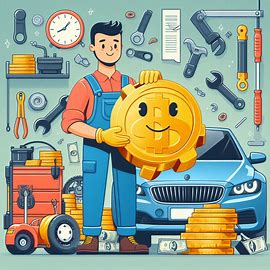
Introduction
Car ownership comes with ongoing responsibilities, and regular car maintenance is one of the most important yet overlooked aspects. Many drivers skip maintenance to save money, only to face higher expenses later due to preventable issues. In this guide, we explore how regular car maintenance saves you money in the long run—through cost avoidance, performance optimization, fuel efficiency, and increased resale value. Whether you’re a new driver or a seasoned vehicle owner, understanding these financial benefits can help you make smarter car care decisions.
1. Preventing Costly Repairs Through Early Detection
1.1 Addressing Issues Before They Escalate
One of the most significant advantages of regular car maintenance is early problem detection. Minor issues such as a worn belt or a dirty air filter, if left unattended, can develop into major mechanical failures.
Examples of early intervention benefits:
- Replacing a worn serpentine belt ($50–$100) vs. fixing engine damage from a snapped belt ($1000+)
- Swapping a dirty air filter ($20–$50) vs. decreased engine performance and higher fuel consumption
Regular inspections help mechanics spot trouble early, saving drivers from unexpected repair bills and vehicle downtime.
1.2 Common Repairs Avoided by Routine Maintenance
Neglected maintenance leads to some of the most expensive car repairs. Simple, affordable checkups can help avoid these larger costs:
| Maintenance Task | Prevents | Cost if Ignored |
|---|---|---|
| Oil Changes | Engine damage | $3000–$5000 for rebuild |
| Brake Checks | Rotor or caliper failure | $400–$1000+ per axle |
| Coolant Flushes | Overheating, radiator damage | $600–$1500+ |
| Transmission Service | Gear slippage, failure | $2000–$4000+ |
Investing a few hundred dollars a year in preventive maintenance could save thousands in the long term.
2. Enhancing Fuel Efficiency
2.1 How Maintenance Affects Fuel Consumption
A well-maintained vehicle uses fuel more efficiently. Poor engine performance, low tire pressure, and clogged filters make your engine work harder, increasing fuel consumption.
Ways maintenance improves fuel efficiency:
- Proper tire inflation reduces rolling resistance
- Clean air filters ensure optimal engine airflow
- Regular oil changes reduce internal friction
According to the U.S. Department of Energy, fixing a serious maintenance issue, like a faulty oxygen sensor, can improve mileage by up to 40%.
2.2 Maintenance Tasks That Save Fuel
Here’s a list of simple yet effective maintenance actions that can lead to fuel savings:
- Tire Pressure Checks: Underinflated tires can reduce gas mileage by 0.2% for every 1 psi drop
- Air Filter Replacements: Can improve acceleration time and fuel efficiency in older vehicles
- Oil Changes: Keeps the engine running smoothly and reduces energy loss
Fuel Savings Table:
| Maintenance Action | Estimated Annual Fuel Savings* |
| Regular Tire Checks | $50–$100 |
| Oil & Filter Changes | $75–$125 |
| Air Filter Replacement | $30–$60 |
| Spark Plug Inspection | $40–$80 |
*Estimates vary by driving habits and vehicle type.
3. Extending Vehicle Lifespan
3.1 Getting More Miles From Your Vehicle
Regular maintenance helps your car last longer by reducing wear and tear. Well-cared-for vehicles often exceed 200,000 miles without major mechanical problems.
Routine care ensures longevity by:
- Keeping systems properly lubricated
- Avoiding internal corrosion
- Reducing overheating and mechanical stress
Proper care can easily extend a car’s life by 5–10 years, translating into substantial savings on buying new or used replacements.
3.2 Financial Benefits of a Longer Lifespan
The longer your car lasts, the more value you extract from your initial investment. Consider the cost breakdown of keeping vs. replacing a vehicle:
| Scenario | Annual Cost Estimate |
| Regular Maintenance | $500–$1000 |
| New Car Purchase | $4000–$8000 (loan + insurance) |
Maintaining a paid-off vehicle is significantly cheaper than making monthly payments on a new one, even factoring in occasional repairs.
4. Boosting Resale and Trade-In Value
4.1 Importance of a Maintenance Record
A well-documented service history can increase your car’s resale or trade-in value. Buyers and dealerships prefer vehicles with consistent upkeep because they’re less likely to break down.
What to track:
- Oil changes and filter replacements
- Tire rotations and alignments
- Major services like timing belt replacement
Tips:
- Use a maintenance logbook or app
- Keep all service receipts
4.2 Resale Price Comparison
Vehicles with poor or no service history tend to depreciate faster. Here’s how maintenance affects resale value:
| Vehicle Age | Good Maintenance | Poor Maintenance |
| 5 years | $10,000 | $7,000 |
| 7 years | $7,500 | $5,000 |
Proper maintenance could mean an extra $2,000–$3,000 in your pocket when it’s time to sell or trade in your car.
5. Smart Maintenance Habits That Save Money
5.1 Stick to the Manufacturer’s Schedule
Every car comes with a recommended service schedule outlined in the owner’s manual. Following it helps avoid unnecessary repairs and ensures warranty compliance.
Key scheduled items:
- Timing belt (typically every 60,000–100,000 miles)
- Transmission fluid (30,000–60,000 miles)
- Brake fluid (every 2–3 years)
Helpful tools:
- Maintenance tracking apps (e.g., Carfax, AUTOsist)
- Calendar reminders
5.2 Combine Appointments and Shop Smart
Bundling services like oil changes and tire rotations can reduce labor costs. Choosing affordable, trusted mechanics also makes a big difference.
Money-saving tips:
- Compare quotes online
- Ask for service bundles or membership discounts
- Use coupons or loyalty rewards
Suggested Table: Sample Bundle Pricing
| Service Bundle | Estimated Cost |
| Oil Change + Tire Rotation | $60–$90 |
| Brake Check + Fluid Top-up | $80–$120 |
| Full Inspection + Diagnostics | $100–$150 |
Conclusion
Regular car maintenance isn’t just a matter of vehicle health—it’s a smart financial strategy. By staying on top of scheduled care, you avoid expensive repairs, save on fuel, prolong your car’s life, and even fetch a higher resale value. Instead of viewing maintenance as a cost, see it as an investment that consistently pays dividends.